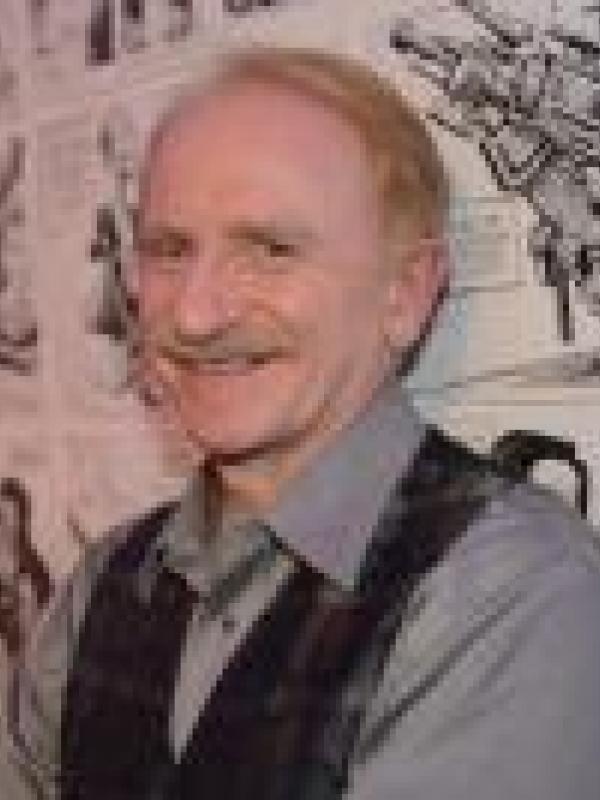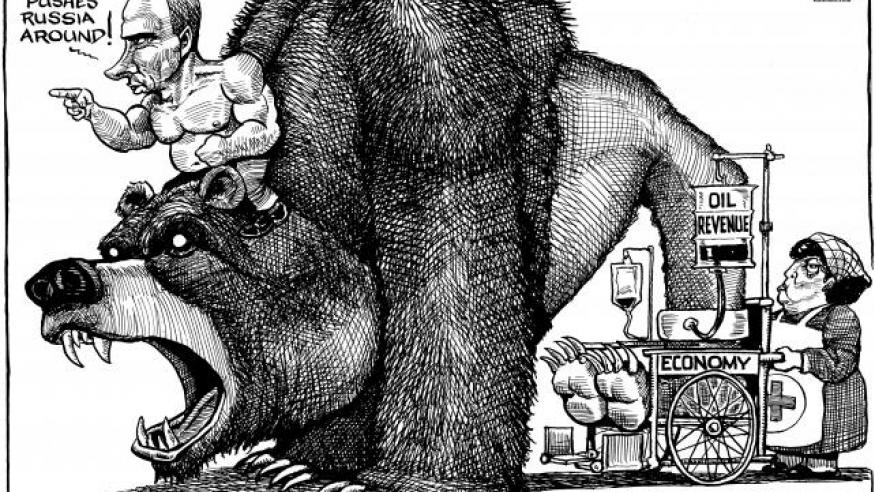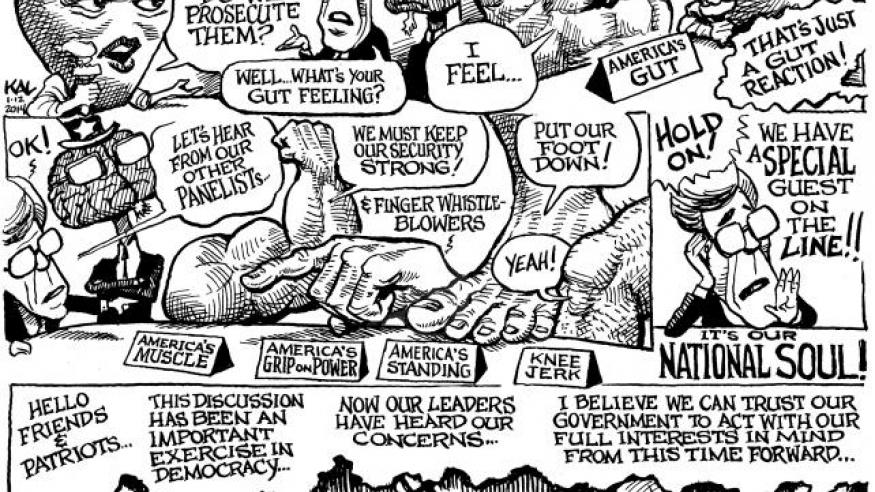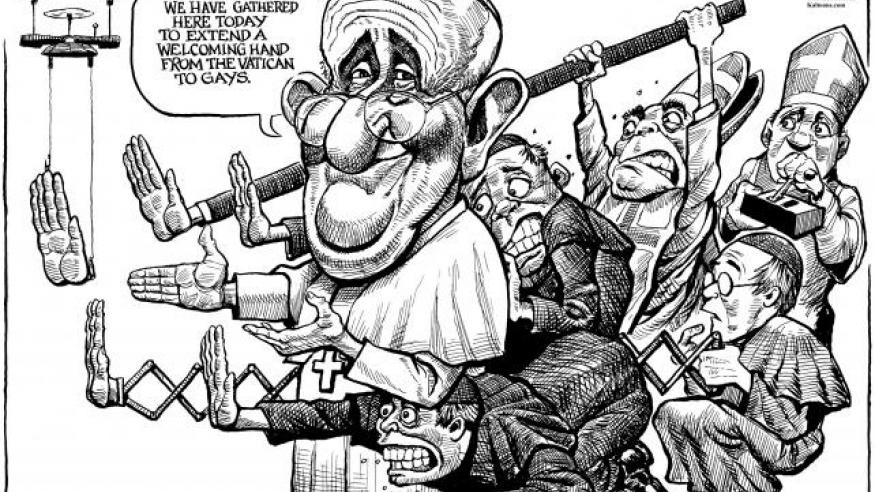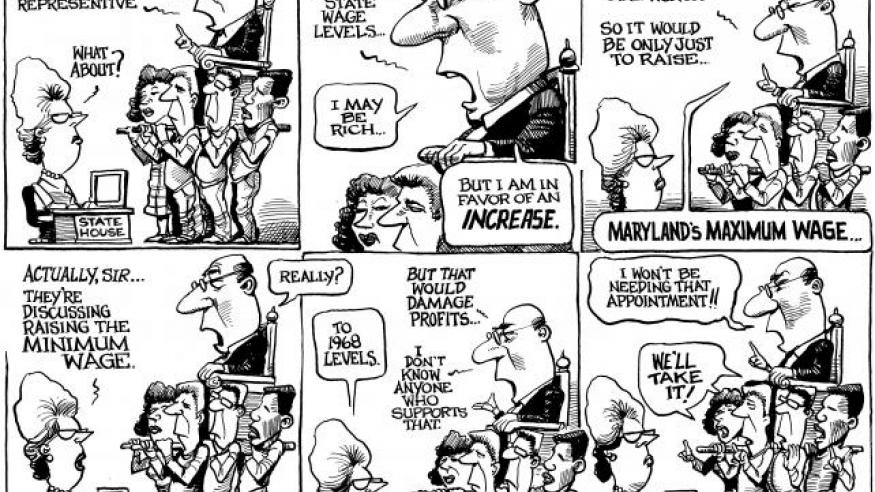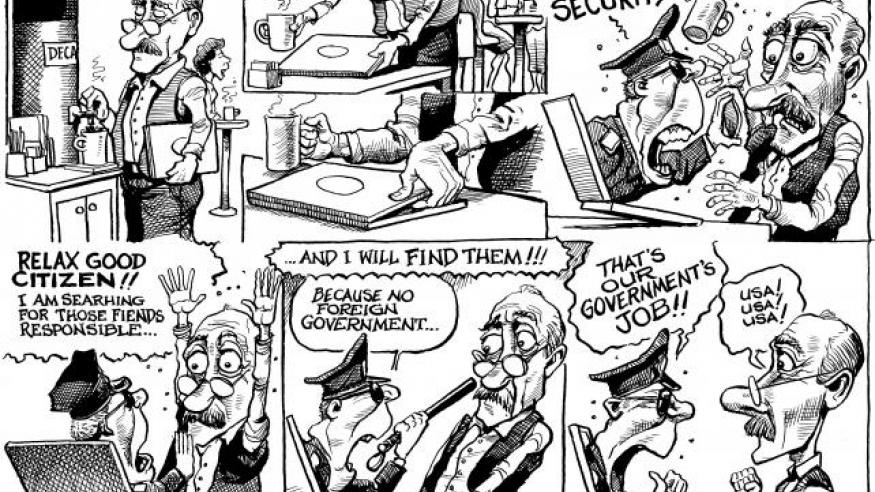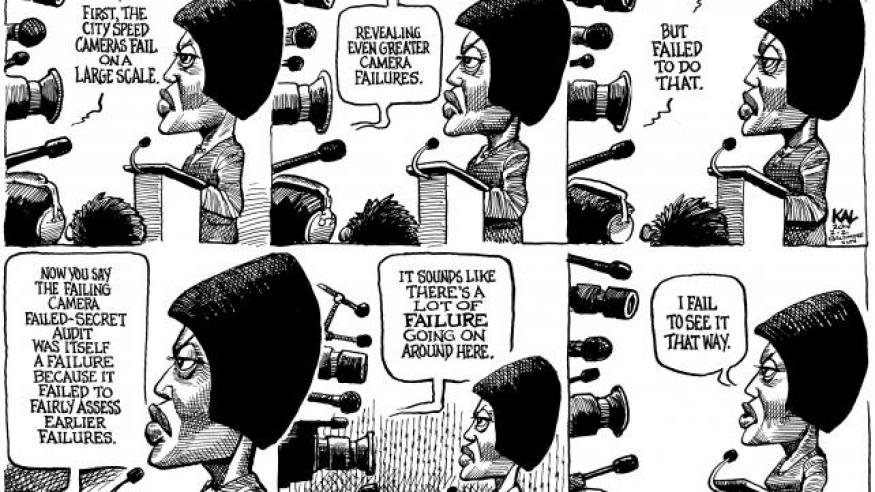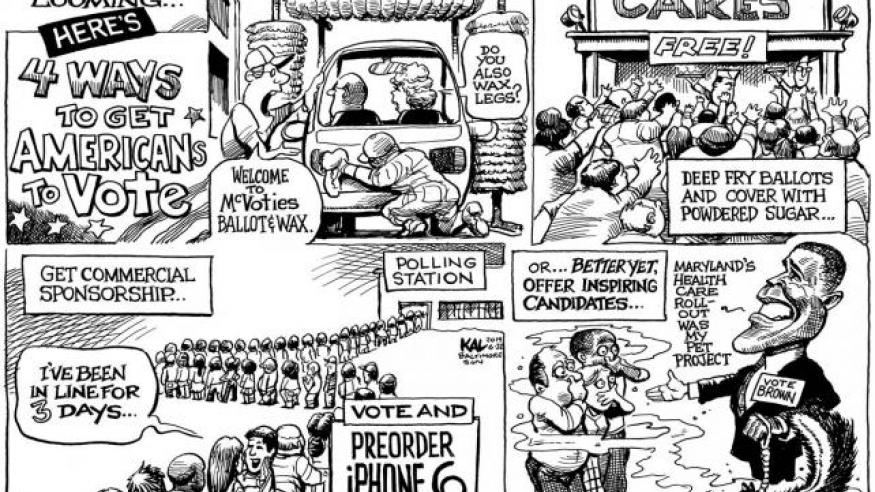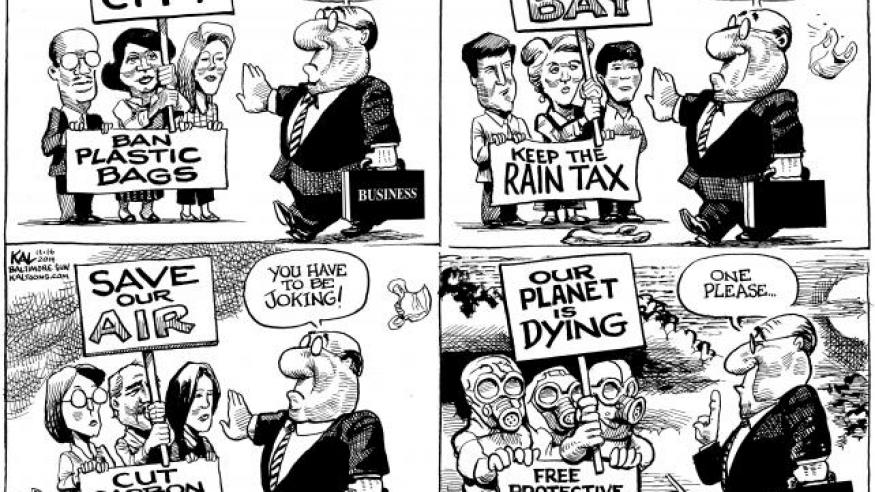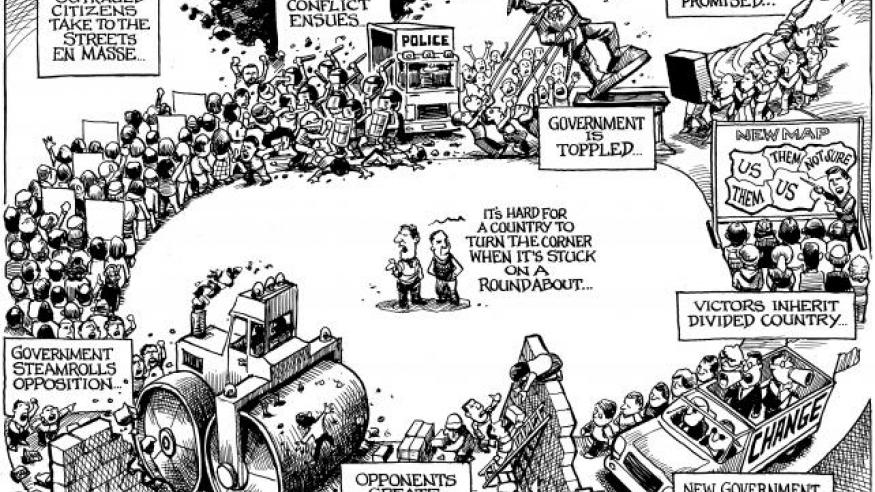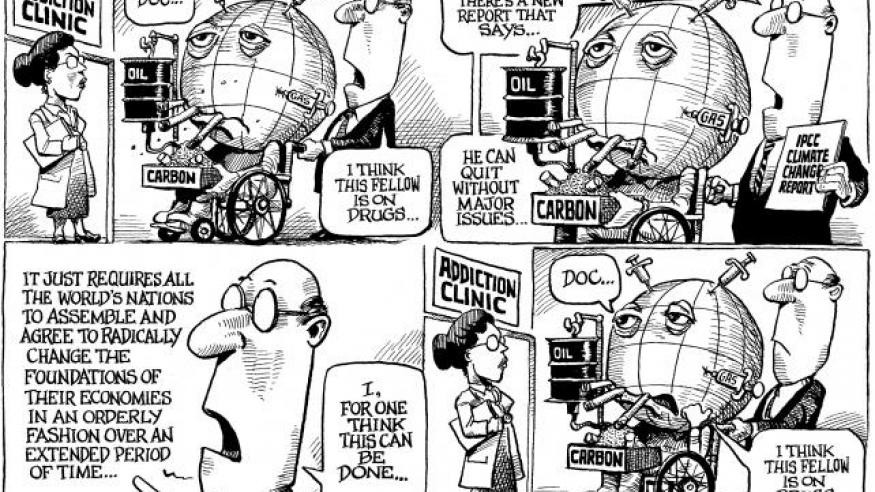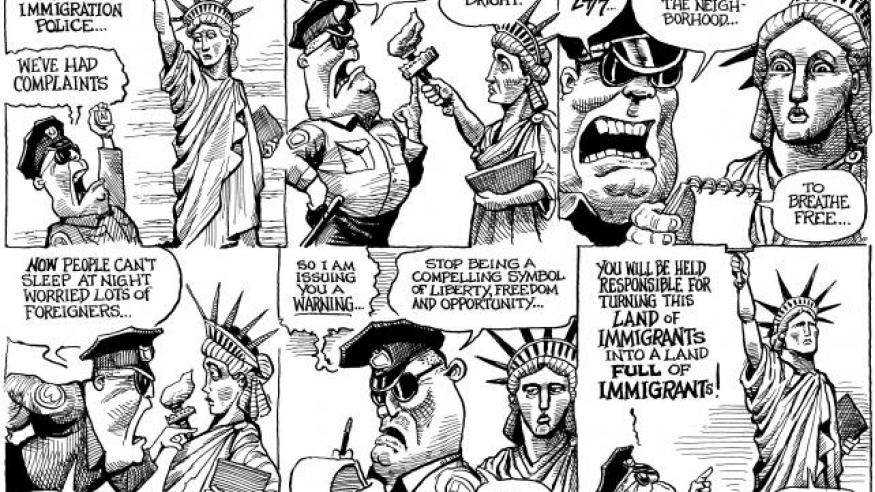Herblock Prize speech 2015
Thank you for the kind introduction and thank you to the Herblock foundation for this great honor.
As my cartoonist colleagues in attendance can attest, we have all seen a brilliant cartoon and thought, “I wish I thought of that one.”
There’s a recent cartoon by Liam Walsh in the New Yorker that fits that bill for me. It is set in an urbane bar with a fellow standing, drink in hand donning a giant dog cone around his neck, the kind used to stop them licking wounds or other tempting parts of their anatomy. He is saying to his partner opposite:
“It keeps me from looking at my phone every two seconds”
So as I stand before you today, I feel that my challenge is to keep you from looking at your phone every two seconds. In fact, if I can keep it to once a minute, I think I will be doing pretty well.
To help me with this task, I have enlisted a tried and tested attention-grabbing device from the Internet.
The listicle.
A listicle is that article/list combo we all see these on sites like Buzzfeed, Facebook and elsewhere. They use sensational adjectives to grab and hold your attention. Like: 10 bodacious beaches where curvaceous celebrities do desperate dieting.
So today I would like to present you with my own listicle:
10 Incredibly expressions of heart-felt gratitude for winning this astonishingly amazing Herblock Prize
The first on my list and the person who should be first on everyone’s list is:
Your mother. I would like to thank my Mom. In addition to her generous act of bringing me into this world…(Btw Good going Mom)
My Mom also helped me get my start on newspapers. I remember as a youngster, my Mom would entice my four siblings and I to draw. She would grab the classified ads section of the Sunday New York Times, spread it out on the kitchen floor, pour a pile of crayons in the middle and let us at it. We would scribble away while my parents would enjoy a smidgeon of peace to read, paint or rest. As a result my Mom has often cited, with a straight face, that I started my career on the New York Times.
Second on my list, I would like to thank my wife Sue. I met Sue in England back in 1979… since then we have enjoyed a rollicking adventure that has spanned two continents, two children, two centuries with one great friendship. Throughout our time together, I have a studio in the house so Sue and our kids Amy and Dan have had to tolerate an ever-present boisterous cartoonist working at all hours of the day and night. I ‘d like to thank them all for their patience, good humor and most importantly affection.
My Mom claims I started on the New York Times… but my real start in the newspaper business was with The Economist, which may be even more improbable. I joined the venerated British weekly just out of college in 1978 while I was working in the UK as basketball player. Which, you are probably thinking is incredibly improbable.
For over 3 decades I have enjoyed great support from Economist team particularly in 1988 when I left England to join the Baltimore Sun.
I agreed to take on the Sun job on the one condition, that I could continue my weekly contribution to The Economist. Fortunately there was this new thing, you may have heard of it called The Internet just coming online. We became the first to use the web as a regular transmission device for artwork. The early efforts were costly and messy. The first cartoons though only 300k in size, the equivalent of an email today, would take up to 3 hours to send.
It is rather better now.
The Economist has a well-earned reputation of a global thought leader while in contrast, The Baltimore Sun, a US metropolitan daily, is known for its local Maryland reportage. Its impressive recent coverage of the civil unrest in Baltimore being a case in point.
When I do cartoons for The Economist, they are often read by millions in virtually every country around the globe. But when I do a cartoon on a local subject for The Sun you can pretty much guarantee the target of the ridicule will read the cartoon… and react to them.
Some will complain to my bosses or respond to me by sending a poisonous letter. Meanwhile former Mayor Kurt Schmoke once had an entirely different response.
He recently shared that a cartoon I drew in 1991 actually changed public policy in Baltimore. The Mayor was ready to enact a dramatic policy to dismember our city’s unsavory red-light district better know as The Block. When I did a cartoon pointing out some of the flaws in his plan, the Mayor took notice. He said the cartoon changed his mind. He scrapped his policy initiatives to bulldoze The Block then moved on other pressing concerns.
Now I feel really good about this… it is a distinct feather in my cap.
I can now die happy knowing my gravestone will read:
Here lies the idiot who saved The Block
Actually, as a person who has a bad habit of tardiness in some things (except cartoon deadlines) the inscription will more likely read:
Here lies the late Kevin Kallaugher
I spent 16 years with The Sun, as it’s daily cartoonist producing about 4000 cartoons. But in 2005 the Sun experienced a cost cutting frenzy that is, unfortunately, all too familiar to newspapers today. The bean counters at the time regarded the editorial cartoonist as an expendable luxury. We parted ways.
It took 7 years and a change of leadership at the paper to recognize the error of those ways. Thanks to Publisher Tim Ryan and editor Andy Green I was invited back.
Now… The Baltimore Sun has a Herblock award-winning cartoonist on its pages!
I hope this will be a positive example for other offending newspapers:
An editorial cartoonist is not a luxury… They are an essential and unequalled form of journalism unique to newspapers. Nothing distills the complex madness of the world to a digestible nugget like the cartoon. Plus it appeals to all readers …particularly the youth that newspapers are so desperate to woo. Even if this death spiral of cuts continues with newspapers into the future, and staffs are reduced to just 5 employees…. It is my opinion that one should be a cartoonist. So a message to all the wayward newspapers out there… stop drawing blanks…hire a cartoonist!
I’d like to thank The Sun and The Economist, number 3 and 4 on my listicle for your support of me and the unique craft of cartooning.
And what a unique craft it is…and one that is hard to learn. For a start, there is no school for editorial cartooning. We have all learned the craft by studying and emulating those who have come before. I feel I need to thank today, (number 5 on my listicle) my cartooning predecessors for their excellent tutelage.
I would like to thank David Levine and Al Hirschfield for their compelling caricatures, Walt Kelly and Roy Peterson for their emotive lettering, Jeff MacNelly and Pat Oliphant for their wicked wit and of course Herblock for his compassion and determined fight for the underdog. There is a piece of all of them, and many others in each of my cartoons.
Number 6:…I would also like to pay homage to my cartoonist brother and sister cartoonists working abroad.
A recent report by Freedom House, a press watchdog group, assessed the state of the world’s press today and they calculated that only 14% of the world’s citizens live in a country with freedom of the press.
My cartoonist colleagues, who work in the 86% of the planet, have an extremely challenging task. Doing a cartoon can mean getting fines, jail-time, torture and worst. I salute my colleagues, like Zunar in Malaysia, Sabir Nazar in Pakistan, Zapiro in South Africa, Bonil in Ecuador who use our special craft as voice for change.
I am inspired by their courage.
But cartooning in the 14% zone can also be dangerous. In January, two brothers attacked Charlie Hebdo and machine-gunned 12 people to their deaths because they objected to some cartoons.
Like many I was deeply saddened by the events of that day… but later I was heartened by the large-scale outpouring of support for cartooning and freedom of expression.
But it wasn’t long before cracks were exposed in this broad-based coalition. People’s support for the cartoonists became parsed with caveats and peppered with regret.
Pundits on the right and left pointed fingers and gnashed teeth over issues of tolerance, religion, satire and where to draw the LINE.
We cartoonists have often been asked in recent months “Where do you draw the line?”
To address that question for you today, I thought I might actually draw the line for you… literally.
(Goes to drawing board)
This question “ where to draw the line?” is a very good one. In fact, it is the perfect cartoon question. It conjures images of sticks in the hand and scratches in the sand…
I have been thinking long and hard over this question and I realize that there is not a line to be drawn… but there are in fact 2 lines.
There is one line that stands behind us. This is not a thin line but a substantial wall. It’s our first amendment. This is a wall of legal protection that shields us and our free speech. It is what keeps us in the 14% of the world. This is a line that is solid and took a long time to build… and does not and should not move.
We cartoonists can practice and excel in our craft because of the strength of this edifice.
The second line is here in front of us. This is the cartoonist’s line of attack.
But this line is drawn in the sand. This is a line that can and does move around… sometimes shifting with the wind.
To complicate things, there are others involved with this line … one hand is the cartoonist who’d like to take the line in one direction. Then there’s the newspaper editor who has a hand in this line’s shape. Consumers of cartoons rarely know the valuable role the editor’s play in a cartoonist’s life. It is with their blessing that cartoons appear and good ones know how to get the best work out of their creative colleague.
I have been blessed with great editors at the Baltimore Sun and The Economist. They are number 7 on my list. All have given me a great deal of freedom to excel in my craft. But I also believe that with freedom comes responsibility. I have made it my business to ensure that my cartoons are journalistically sound and cannot be perceived as sexist, racist.
It can be hard editing a cartoonist because we dance in a minefield of sensibilities. We are constantly treading on delicate subjects with ridicule and negativity.
As masters of negativity, I like to describe the cartoonist/satirist as the sheep dogs of society. Let me explain…
When society moves forward in a new direction, it is caused by two catalysts. The first are leaders who surge to the front of the crowd with a flag or a banner and shout:
“FOLLOW ME!”
Then, there are the cartoonists… We want the society to move forward, but our form of motivation is quite the opposite. We go around to the back of the crowd, and like a sheep dog, bite everyone in the rear end.
But there are some who do not like the nature of our bite or the size of our teeth.
These are the third hand trying to grab the cartoonist’s line of attack. This hand belongs to the religious, political, business and societal forces that would claim jurisdiction over the imagery and messages that can be employed in the cartoons.
This can create a tug of war with this line. Creating tensions between the satirists and the sensibilities of some in society.
This tug of war, I think this is a good contest to have.
We can definitely have a healthy give and take as what comprises a responsible line of attack. We saw it this week with the writers of PEN America debating the merits of awarding Charlie Hebdo, a prize for courage.
These robust debates over this line strengthen our society, in part because they remind us how lucky we are to be standing here bolstered by this line our freedom of expression is…
But if we are going to have these discussions, they must be done face to face, heart to heart and not like in Paris…gun to head.
Number 8 on the list, I thought that I should invite an old friend to the proceedings tonight. His presence looms large here… after all; the cartoon prize is named after him. I thought I would have Herb join us tonight because I have a question to ask him.
I have been doing this for 37 years and created 8000 cartoons…Herblock at this stage had another 35 years to go before retirement.
Pretty impressive numbers…
I wanted to ask Herb if he had any advise for me tonight … I think he would probably tell me
Back to the drawing boar, Kid! And, you know, he’s right.
When I look at the follies and foibles of our politicians, I think I could create another 8000 cartoons Easy!
In fact there is enough material to keep a WHOLE army of cartoonists busy.
So my advice to all the newspapers out there, including the New York Times…
Follow my Mom’s example… give us some space on your paper… AND LET US AT IT!
Just 2 more on the list to go. I would like once again like to thank the Herblock Foundation for keeping the legacy of Herblock alive as we move deeper into the 21st century, and their tremendous support for the Art of Editorial cartooning which we hope to be enjoying centuries into the future.
Finally, #10 on the listicle… I would like to thank all of you, the audience who have come here tonight for this celebration. I am honored by your presence and flattered that, on the most part, you didn’t look at your cell phones every two seconds.
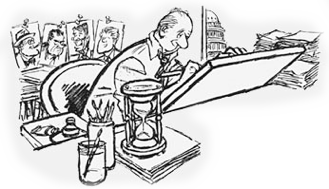 Herb Block is among the world’s best known and most admired political cartoonists. Born on October 13, 1909, the native Chicagoan spent his 72-year career fighting against abuses of the powerful.
Herb Block is among the world’s best known and most admired political cartoonists. Born on October 13, 1909, the native Chicagoan spent his 72-year career fighting against abuses of the powerful.
